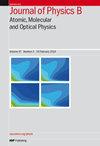A comparative study of transition oscillator strengths and static polarizabilities of the hydrogen atom confined in Gaussian potential
IF 1.5
4区 物理与天体物理
Q3 OPTICS
Journal of Physics B: Atomic, Molecular and Optical Physics
Pub Date : 2024-08-13
DOI:10.1088/1361-6455/ad6b66
引用次数: 0
Abstract
The multipole (dipole, quadrupole, and octopole) photon-absorption transition oscillator strengths for the ground state of hydrogen atom confined in Gaussian potential are investigated for a great variety of potential depths and confining radii. It is interestingly found that at fixed potential depth the gradual increase of confining radius shows first destructive and then constructive effect on the multipole oscillator strengths. Such an effect can be understood from the overlap between the initial and final states. Multipole polarizabilities of the system are obtained through the sum-over-states formalism where the contributions from both the bound and continuum spectra of the system are included. Although the separate bound and continuum contributions can not be determined accurately, due to the long-range nature of the Coulomb potential introduced by the nucleus, their summations can be obtained to reasonably good accuracy, leading to fast convergence of numerical calculations of multipole polarizabilities. The present results are compared with previous calculations available in the literature. Although good agreement is observed for the dipole polarizability, significant differences exist in the quadrupole polarizability and orders-of-magnitude differences appear in the octopole polarizability. The possible reason for such large differences is analyzed by comparing the sum rule of corresponding oscillator strengths.限制在高斯势中的氢原子的过渡振荡器强度和静态极化率的比较研究
研究了氢原子在高斯势约束下基态的多极(偶极、四极和八极)光子吸收转变振荡器强度,并对各种势深和约束半径进行了研究。有趣的是,在固定的电位深度下,约束半径的逐渐增大对多极振荡器强度的影响先是破坏性的,然后才是建设性的。这种效应可以从初始状态和最终状态的重叠中得到理解。系统的多极极化率是通过态上总和形式主义得到的,其中包含了系统的束缚和连续谱的贡献。虽然无法精确确定单独的束缚和连续贡献,但由于原子核引入的库仑势的长程性质,它们的求和可以获得相当高的精度,从而使多极极化率的数值计算快速收敛。本研究结果与以往文献中的计算结果进行了比较。虽然在偶极极化率方面观察到了良好的一致性,但在四极极化率方面存在显著差异,而在八极极化率方面则出现了数量级的差异。通过比较相应振子强度的总和规则,分析了出现如此大差异的可能原因。
本文章由计算机程序翻译,如有差异,请以英文原文为准。
求助全文
约1分钟内获得全文
求助全文
来源期刊
CiteScore
3.60
自引率
6.20%
发文量
182
审稿时长
2.8 months
期刊介绍:
Published twice-monthly (24 issues per year), Journal of Physics B: Atomic, Molecular and Optical Physics covers the study of atoms, ions, molecules and clusters, and their structure and interactions with particles, photons or fields. The journal also publishes articles dealing with those aspects of spectroscopy, quantum optics and non-linear optics, laser physics, astrophysics, plasma physics, chemical physics, optical cooling and trapping and other investigations where the objects of study are the elementary atomic, ionic or molecular properties of processes.

 求助内容:
求助内容: 应助结果提醒方式:
应助结果提醒方式:


